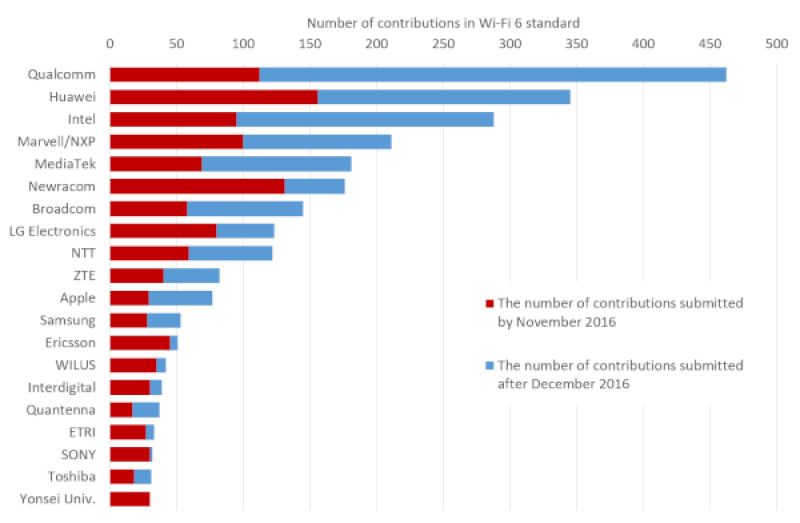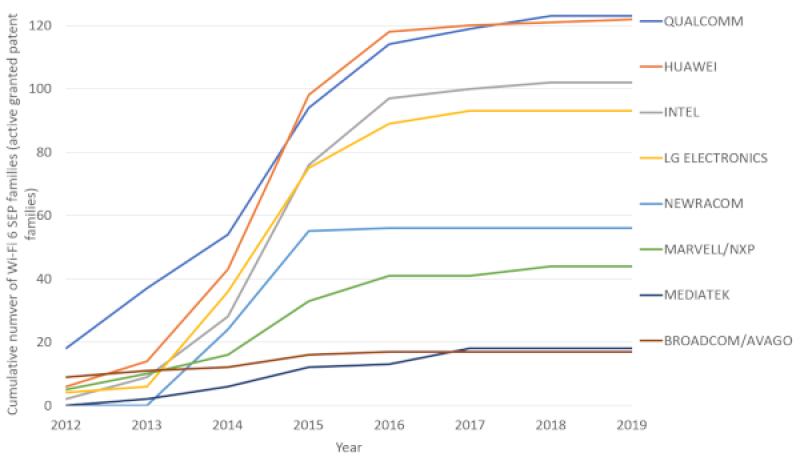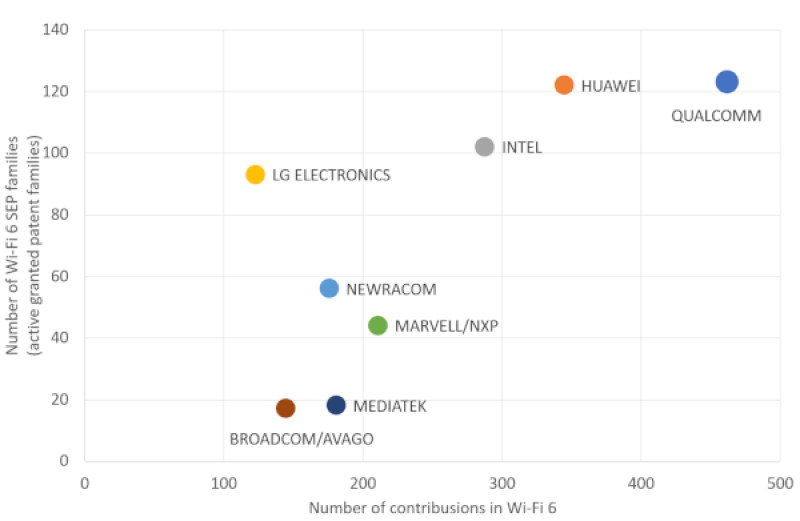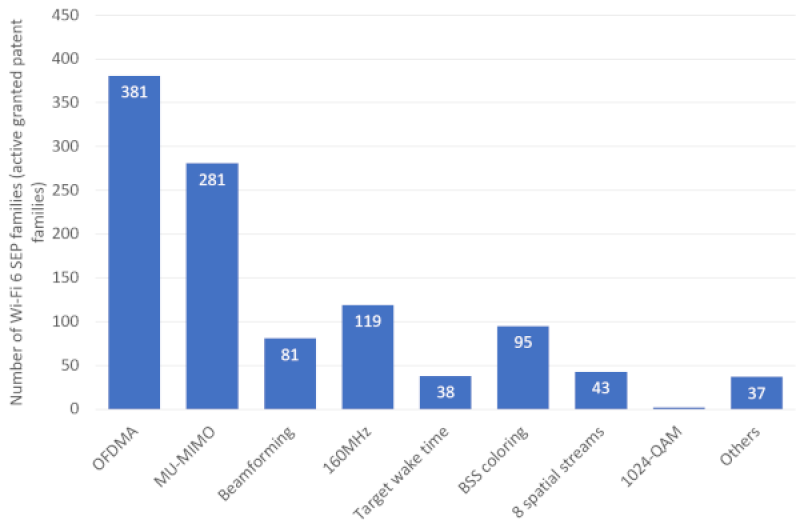This report is an updated version of our Essentiality Report on Wi-Fi 6 Patents, published in September 2020, and shows the latest status of Wi-Fi 6 standard-essential patents (SEPs).
Wi-Fi 6 (802.11ax)
What is it?
Today, Wi-Fi is available at home, office, school, restaurants and stores as standard; it is a well-known technology.
Wi-Fi standards are set by the Institute of Electrical and Electronics Engineers (IEEE), and letters after IEEE 802.11 indicate the generation of the Wi-Fi standards. The official name of the Wi-Fi 6 standard is IEEE802.11ax. Wi-Fi is also the brand name used by the Wi-Fi Alliance, an industry group that aims to promote the technology.
IEEE802.11ax is the latest Wi-Fi standard in practice, and Wi-Fi 6 technology offers benefits such as higher data rates, increased capacity, performance in environments with many connected devices, and improved power efficiency. In addition, the main functions include OFDMA (orthogonal frequency division multiple access), MU-MIMO (downlink multi-user multiple input, multiple output), beamforming, 160 MHz (160 MHz channel bandwidth), target wake time, BSS colouring, 8 spatial streams, and 1024-QAM (1024 quadrature amplitude modulation mode).
Thus, Wi-Fi 6 technology can be applied to a wide range of use cases, for example, in a high-density environment with a lot of people in a stadium or an educational site, or with a lot of devices in a manufacturing facility.
It is expected that there will be more than 13 billion Wi-Fi 6 devices shipped by 2026 with a growth rate of around ~26% between 2020 and 2026.
Wi-Fi 6 standardisation activities in IEEE and key players
To further improve the efficiency of Wi-Fi, shortly after the release of IEEE 802.11ac (Wi-Fi 5) in March 2013, IEEE 802.11 set up a study group (SG) named HEW (High-Efficiency Wireless). In March 2014, the IEEE 802 executive committee approved the PAR (Project Authorisation Request) of the HEW SG, and the 802.11 Task Group ax (TGax) was formed to develop the technical specification. IEEE 802.11ax released Draft 1.0 in November 2016, Draft 2.0 in October 2017, Draft 3.0 in June 2018, Draft 4.0 in January 2019, Draft 5.0 in September 2019, Draft 6.0 in November 2019, Draft 7.0 in August 2020, and Draft 8.0 in November 2020. IEEE 802.11ax was finally accepted as a standard on February 9 2021 and it was published on May 19.
To understand the key players in the Wi-Fi 6 standardisation activities, we analysed the number of contributions in TGax and the HEW SG by using the IEEE official website (see Figure 1). If there were multiple versions in a single contribution, the multiple versions were counted together as one contribution.
Figure 1 shows the cumulative number of contributions published from 2013 to 2021, i.e., the top 20 contributors up to March 2021. The red bars show the cumulative number of contributions submitted by November 2016, when Draft 1.0 was released, and the blue bars show the contributions submitted after that date. Draft 1.0 defines most of the basic features; and some chipset companies started to design new chips around the release of the Draft 1.0. Huawei was in the leading position before Draft 1.0 was released. Qualcomm, in first place overall, has increased the number of contributions especially after Draft 1.0 was released.
Figure 1: Number of contributions in Wi-Fi 6: top 20 contributors

Purpose of analysing essentiality of Wi-Fi 6 related patent families
We aim to clarify the current status of Wi-Fi 6 SEP families by manually making technical essentiality searches of Wi-Fi 6 related patent families.
The terms ‘Wi-Fi 6 related patent family’ and ‘Wi-Fi 6 SEP family’ used in this report have the following meanings:
Wi-Fi 6 related patent family means an active granted patent family (i) which has at least one granted patent in the US, EPO, Japan, China and Korea as of April 1 2021, where the active granted patent family has a specification including keywords relating to ‘802.11ax’ (e.g., TGax, HEW, 802.11ax), and (ii) which lists at least one participant who attended TGax from the top 20 contributors in Figure 1 as an inventor of the active granted patent family.
Wi-Fi 6 SEP family means a patent family with a granted patent of which independent claim(s) substantially read onto features of the target standard as a result of our manual essentiality review of the granted patent in the Wi-Fi 6 related family.
This report does not consider the validity of each Wi-Fi 6 SEP.
Our challenge was to identify the Wi-Fi 6 related patent families where almost all patent owners relating to Wi-Fi 6 submitted a blanket declaration without listing any patent according to the IEEE IPR policy (see below). For reference, we can easily identify declared patents in 3GPP since patent owners have to specify all patents to be declared according to the European Telecommunications Standards Institute’s (ETSI) IPR policy.
We hope that this report highlights the current situation of the Wi-Fi 6 SEP race, and helps many stakeholders relating to Wi-Fi 6 to have more practical discussions and make better determinations.
Patent analysis methodology
Method of retrieving Wi-Fi 6 related patent families
IEEE permits blanket declarations that do not disclose specific patent numbers in SEP declarations. While blanket declarations provide broader FRAND assurances to patentees, they bring difficulty in seeing the landscape of SEP ownership by not identifying specific patents.
To retrieve Wi-Fi 6 related patent families, we focused on patents filed by the top 20 contributors in Figure 1, which include participants attending the TGax, to make a population, and added to the population patents with keywords relating to 802.11ax to get a final population. The Wi-Fi 6 related patent families have at least one granted patent in the US, EPO, Japan, China and Korea. We executed the search by using the Questel Orbit database on April 1 2021.
Method of essentiality review for Wi-Fi 6 related patent families
The essentiality of each Wi-Fi 6 related patent family (4,919 in total) for the Wi-Fi 6 standard was determined by comparison with the target standard documents. In our previous report published in September 2020, Wi-Fi 6 related patent families as of April 6 2020 were analysed by comparison with the draft version of Wi-Fi 6 IEEE P802.11ax™/D6.0 and IEEE P802.11REVmd/D3.0. In this report, Wi-Fi 6 related patent families which were newly granted between April 7 2020 and April 1 2021 in the Questel Orbit database were analysed by comparison with the latest draft version of Wi-Fi 6 IEEE P802.11ax™/D8.0, which is equivalent to the officially approved IEEE 802.11ax. In more detail, the following steps were used to extract Wi-Fi 6 SEP families.
Step 1: Relevancy check
Our analysts conducted a manual review of Wi-Fi 6 related patent families to identify the relevant patent data. The relevancy check of each patent was conducted to ascertain its relevancy to various aspects of the target standard.
The relevancy review was performed based on analysis of one representative granted patent per family. Further, the review was primarily based on analysis of the title, abstract, and claim(s) of each representative granted patent. When necessary, our analysts also referred to the specification of the representative granted patent.
For each patent family, the representative granted patent for this step was the latest granted patent in the US, EPO, Japan, China and Korea as of April 1 2021, and active (not lapsed nor expired) as of the same date.
The representative granted patent published in languages other than English was analysed using machine-translated text obtained from Espacenet.
Step 2: Substantive analysis (essentiality analysis and categorisation)
The relevant patent data from Step 1 was considered in this phase. The substantive analysis included essentiality analysis and categorisation as follows.
Essentiality analysis:
For determining the essentiality of each relevant patent family from Step 1, our analysts compared the independent claim(s) of the representative granted patent with one or more technical features present in the target standard. Based on the extent of overlap between the independent claim and the identified features, we determined a Wi-Fi 6 related patent family as essential when the representative granted patent’s independent claim(s) substantially read onto features of the target standard.
The Wi-Fi 6 related patent families as of April 6 2020 in our previous report published in September 2020 were analysed by comparison with the draft version of Wi-Fi 6 IEEE P802.11ax™/D6.0 and IEEE P802.11REVmd/D3.0.
Wi-Fi 6 related patent families which were newly recorded between April 7 2020 and April 1 2021 in the Questel Orbit database were analysed by comparison with the latest draft version of Wi-Fi 6 IEEE P802.11ax™/D8.0. The newly granted family includes those first granted in the five countries after April 6 2020 and those newly granted after April 6 2020 in a different country to the country having the granted patent of the Wi-Fi 6 related patent family in our previous report.
Categorisation:
Each relevant patent family from Step 1 was manually reviewed and categorised into one or more relevant technical categories listed below.
First dimension
PHY (Physical Layer)
MAC (Medium Access Control Layer)
Second dimension
OFDMA
MU-MIMO
Beamforming
160MHz
Target wake time
BSS colouring
8 spatial streams
1024-QAM
The categorisation was performed based on manual review of the representative granted patent per patent family. Further, the categorisation was primarily based on analysis of the title, abstract, and claim(s) of each representative granted patent. When necessary, our analysts also referred to the specification of the representative granted patent.
Landscape of Wi-Fi 6 SEP families
Wi-Fi 6 SEP owners ranking
The total number of Wi-Fi 6 SEP families of the top 20 contributors was 645 as of April 1 2021, an increase of 28 (+4.5%) compared with our previous report. Figure 2 shows a ranking of the top eight companies by families. Qualcomm and Huawei, with more than 120 Wi-Fi 6 SEP families, lead the way followed by Intel, LG Electronics, Newracom, and Marvell. This is mainly because Qualcomm and Huawei have submitted the most contributions in TGax and HEW SG for Wi-Fi 6 (see Figure 1). The number of families of Marvell includes the patent families transferred from the company to NXP Semiconductors.
Figure 2: Wi-Fi 6 SEP owners ranking
Wi-Fi 6 SEPs |
||
Number |
Proportion |
|
QUALCOMM |
123 |
19.1% |
HUAWEI |
122 |
18.9% |
INTEL |
102 |
15.8% |
LG ELECTRONICS |
93 |
14.4% |
NEWRACOM |
56 |
8.7% |
MARVELL/NXP |
44 |
6.8% |
MEDIATEK |
18 |
2.8% |
BROADCOM/AVAGO |
17 |
2.6% |
Others |
70 |
10.9% |
Cumulative number of Wi-Fi 6 SEP families
Figure 3 shows the cumulative number of Wi-Fi 6 SEP families owned by each company in terms of priority year. Because this analysis is based on granted patent families as of April 1 2021 and does not count patent families with only pending applications under examination, we can see that there are few increases in the number of families from 2016 to 2019. HEW SG started its activity to consider the improvement of spectrum efficiency to enhance the system throughput/area in high density scenarios of APs and/or STAs in May 2013, TGax discussions started in May 2014, and the first draft (Draft 1.0) was released in November 2016. Hence, there seems to be an increased number of Wi-Fi 6 SEP families around the years 2014, 2015, and 2016, as they laid the basic building blocks for Draft 1.0. Qualcomm and Huawei rank highest in terms of the number of Wi-Fi SEP families filed in and after 2014.
Figure 3: Cumulative number of Wi-Fi 6 SEP families counted by priority year

Correlation between the number of contributions and the number of Wi-Fi 6 SEP families
Figure 4 shows that there is a positive correlation between the number of contributions in Wi-Fi 6 and the number of Wi-Fi 6 SEP families for the top eight companies, while we can see a deviation depending on the company.
Figure 4: Correlation between the number of contributions and the number of Wi-Fi 6 SEP families

Categorisation of Wi-Fi 6 SEP families
PHY/MAC
Figures 5 and 6 show the number of Wi-Fi 6 SEP families relating to PHY and MAC (i.e., the first dimension) respectively. Huawei is in the leading position in PHY, followed by LG, Intel, and Qualcomm. Qualcomm is top in MAC, followed by Huawei and Intel.
Figure 5: Number of Wi-Fi 6 SEP families relating to PHY
Wi-Fi 6 SEPs (PHY) |
||
Number |
Proportion |
|
HUAWEI |
61 |
18.6% |
LG ELECTRONICS |
59 |
18.0% |
INTEL |
57 |
17.4% |
QUALCOMM |
52 |
15.9% |
NEWRACOM |
30 |
9.1% |
MARVELL/NXP |
24 |
7.3% |
MEDIATEK |
12 |
3.7% |
BROADCOM/AVAGO |
12 |
3.7% |
Others |
21 |
6.4% |
Figure 6: Number of Wi-Fi 6 SEP families relating to MAC
Wi-Fi 6 SEPs (MAC) |
||
Number |
Proportion |
|
QUALCOMM |
71 |
22.5% |
HUAWEI |
62 |
19.6% |
INTEL |
45 |
14.2% |
LG ELECTRONICS |
34 |
10.8% |
NEWRACOM |
26 |
8.2% |
MARVELL/NXP |
19 |
6.0% |
BROADCOM/AVAGO |
7 |
2.2% |
MEDIATEK |
6 |
1.9% |
Others |
46 |
14.6% |
OFDMA
Figure 7 shows the number of Wi-Fi 6 SEP families relating to OFDMA, MU-MIMO, beamforming, 160MHz, target wake time, BSS colouring, 8 spatial streams, and 1024-QAM. As shown in Figure 7, OFDMA has the highest number of Wi-Fi 6 SEP families in the second dimension and contributes more than half of the total Wi-Fi 6 SEP families. The Wi-Fi 6 standard specifies an enhancement to MU-MIMO in a previous-generation standard, based on a new access mechanism of OFDMA, so MU-MIMO SEP families have a big overlap with OFDMA SEP families. In this section, the analysis focuses on the Wi-Fi 6 SEP families relating to OFDMA. OFDMA is a multiple access mode in 802.11ax and was first introduced into a Wi-Fi system. OFDMA more effectively shares channels to increase network efficiency and lower latency for both uplink and downlink traffic in high demand environments.
Figure 7: Number of Wi-Fi 6 SEP families in the second dimension

Figure 8 shows the top eight companies in terms of the number of Wi-Fi 6 SEP families relating to OFDMA. Among the top companies, Huawei holds the highest number, followed by Intel, Qualcomm, and LG.
Figure 8: OFDMA related Wi-Fi 6 SEP owners ranking
Wi-Fi 6 SEPs (OFDMA) |
||
Number |
Proportion |
|
HUAWEI |
83 |
21.8% |
INTEL |
62 |
16.3% |
QUALCOMM |
58 |
15.2% |
LG ELECTRONICS |
57 |
15.0% |
NEWRACOM |
33 |
8.7% |
MARVELL/NXP |
23 |
6.0% |
BROADCOM/AVAGO |
15 |
3.9% |
MEDIATEK |
10 |
2.6% |
Others |
40 |
10.5% |
Takeaways
Qualcomm and Huawei still lead the SEP race for Wi-Fi-6 technology, according to our analysis results. Qualcomm has 123 Wi-Fi 6 SEP families, one more than its Chinese rival Huawei. Intel comes in third with 102, followed by LG Electronics (93) and Newracom (56).
The key takeaways are as follows:
1.The total number of Wi-Fi 6 SEP families of the top 20 contributors is 645 as of April 1 2021, which is an increase of 28 (+4.5%) compared with our previous report.
2.There is a positive correlation between the number of contributions in Wi-Fi 6 and the number of Wi-Fi 6 SEP families.
3.Huawei leads the way in the number of Wi-Fi 6 SEP families relating to PHY, followed by LG, Intel, and Qualcomm. Qualcomm is top for the number of families relating to MAC, followed by Huawei and Intel.
4.OFDMA is a focused area in Wi-Fi 6 SEPs, and Huawei ranks highest here, followed by Intel, Qualcomm, and LG.
We hope that this report helps many stakeholders relating to Wi-Fi 6 technology to have more practical discussions and make better determinations.
Yuji Orita is general manger, and Toshihiro Nakane manager, at IP research institute NGB Corporation in Tokyo.











